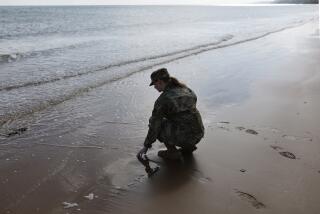Prince, Diana Mark 900th Anniversary of Death : Charles Hails Ancestor: William the Conqueror
- Share via
CAEN, France — The last foreigner to subjugate England was a Norman duke in the middle ages named William, and France commemorated the 900th anniversary of his death Wednesday with a pontifical Mass in the presence of one of his descendants, the Prince of Wales.
It was a warm, sunlit day of pageantry, ceremony, celebrity gawking, small talk and good feeling as Prince Charles and Princess Diana sat in the church of the great abbey that William, nicknamed the Conqueror, had built in Caen and where his tomb is. Then the royal couple were driven to Bayeux to look at the enormous and magnificent tapestry commissioned by William’s wife, Queen Mathilde, to tell the full story of the conquest in 1066.
“William I of England and the Duke of Normandy is a figure of great importance to both our countries,” Charles said in a brief address in French to French officials in Caen City Hall. “We know him in England, of course, as our first Norman king, the present queen’s--and therefore my own--distant ancestor.
“We should not forget either the importance of his achievement here in uniting the duchy of Normandy or his entwining the destinies of our two countries.”
The Prince and Princess of Wales gave a two-volume facsimile of the Domesday Book to the city of Bayeux so it can be displayed in the same building as the tapestry. William had ordered the compilation of the book, a comprehensive survey of all the lands of England that he had distributed to his nobles. It is looked on now as a wonder of medieval administration and law.
“Once you got your name into this book,” explained Joe Studholme, the publisher of the facsimile, “you had lost your land to the French. That is why the British called it a doomsday book. William was a ruthless king.”
But, for the most part, ancient grievances were played down during the day. Celebrating the Mass with Archbishop Jean Badre of Bayeux and Lisieux, Cardinal Basil Hume, the Roman Catholic primate of England, recalled that the era of William had been filled with a great many unhappy incidents, such as the attempt of Norman soldiers to plunder Westminster Abbey when William was crowned there.
“But it is possible,” the cardinal said in French, “to see the straw in other people’s eyes without seeing the great wooden beam in your own. Are we really less brutal than they were?”
During the Mass, Charles and Diana were led to the tomb of William behind the altar. Over the centuries, the tomb has been sacked several times during French religious wars, and the present tomb was rebuilt in 1984. Only one bone lies within it. The rest of William’s remains have been lost.
William, the Duke of Normandy, based his claim to the throne of England on a promise from his childless cousin, King Edward the Confessor, to make him his heir. But by the time Edward died, he had instead named Harold, a Saxon from one of England’s most powerful families. William then assembled a great armada, sailed across the English Channel and defeated Harold at the Battle of Hastings in 1066.
The Norman conquest had a great deal of influence on England and on the English language even though England separated from Normandy a century and a half later.
Wednesday was not completely solemn or historical. Ouest France, the regional newspaper, set one tone by running an English headline over its main story of the day. “Hello Lady Di!” it said. The newspaper published an itinerary titled, “Where to See Prince Charles and Lady Diana.” And hundreds of Normans lined the streets to see the royal couple, especially the princess, dressed in a red and black suit, with a Spanish-style hat.
The Caen City Hall is part of the abbey that William had built to appease a pope who had excommunicated him for marrying his cousin, Mathilde. When the prince and princess arrived in the magnificent setting, they were greeted by schoolchildren singing songs written for the anniversary and two Caen townspeople on horseback in William and Mathilde costumes. The leather William costume was designed by Christian Dior.
More to Read
Sign up for Essential California
The most important California stories and recommendations in your inbox every morning.
You may occasionally receive promotional content from the Los Angeles Times.













